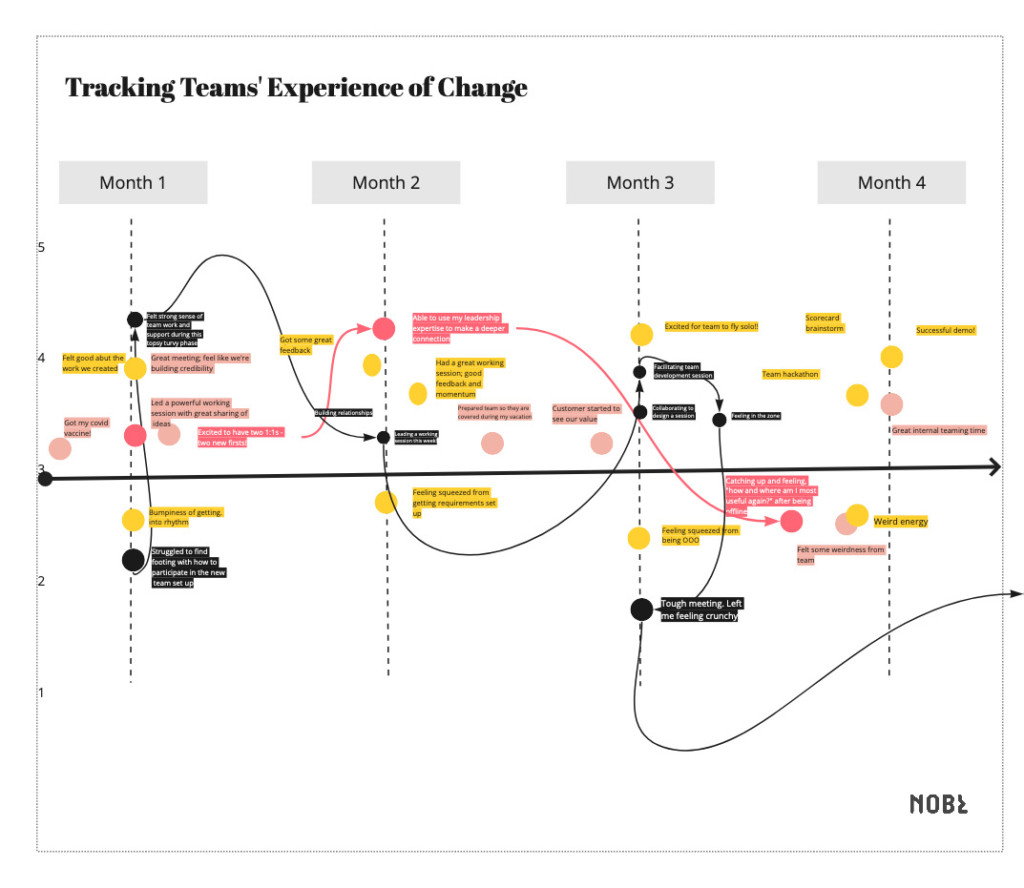You’ve been working on a change initiative for months, and now it’s time to involve your team. The time you’ve spent seeing it, shaping it, and wrestling with what it means has been fulfilling, if exhausting. Truth be told, you’re ready to just get on with it. Conceiving and creating a change, though, require two different skill sets: you’re not at the finish line so much as a new starting point.
If you want to create actual change, you’ll need your team’s commitment, not just their compliance. That means you’ll need people to carry your message into conversations you won’t be a part of, and add specific “how-tos” in ways you haven’t thought of yet—all for something your team may not have asked for in the first place. Understanding your team’s experience of change can help you meet them where they are. Here are some of the most common reactions we’ve seen in teams, and how you can address them as a leader:
- Their existing trust in your leadership and each other will influence your ability to change. Trust enables teams to be vulnerable and take the risks required to try new things as the change journey commences. If your team is low on trust, don’t worry; all is not lost. It just means you need to set goals around rebuilding trust in addition to making change.
- Their motivations will be different than yours. Your excitement for a change may be fueled by seeing how it fits into a bigger strategy or moves your company forward. But for your team, motivation may come from the opportunity to gain a skill set, free up time, or work more closely with different people in the company. When inviting your team to be involved in this change, share what you see as the benefits, and leave room for people to articulate gains from their point of view. They’ll be more committed to their own “whys” than any you can create, regardless of how valid.
- They’ll silently be waiting for the other shoe to drop. When you announce things will be changing, your team may start to question what else might be changing that they don’t know about. Show them what familiar truths will stay constant throughout this journey. For example, they may still provide value to the same customer, still make certain decisions regarding how they work, and still be seen internally as critical to business success. Pointing out the familiar creates a sense of security that allows people to continue to be productive even when things are changing.
- They’ll wonder how these changes will impact what’s expected of them. One of the first things teams ask is “how will my work be affected?” and “what do I need to do differently?” You may be tempted to wait until you have all the answers. Instead, give them a framework by defining expectations in terms of the effect you want to have on customers (outcomes), rather than the exact products and services it will take to get there (outputs). In doing so, you take off the pressure to have all the answers and leave room for your team to help create the tools and processes needed to get to the desired endpoint.
- They’ll take cues from each other to determine if this is a good thing or a bad thing. Just as we take cues from a movie’s soundtrack to determine if we should be happy or sad about what we’re seeing, your team will take cues from each other to decide how to react to the changes ahead. Look for the influencers—the people with their finger on the pulse of the culture—to better understand what’s in the hearts and minds of your team as you embark on this change together. By doing so, you’ll provide insights influencers can take back to the informal network to help shape perceptions and limit misconceptions.
- Their attitudes towards change will change. Today’s skeptic may be tomorrow’s champion, so help the team realize their feelings and energy for this change may shift unexpectedly, and give them a place to talk about it. For instance, take a monthly pulse survey asking “On a scale from 1-5, how are you feeling about this change?” Then map it over time and talk about what happened. Look for patterns in how feelings change over time, and how feelings differ within the group at a single point in time. Observing the change journey can help explain what discord the team may be experiencing, and give you a way to talk about how to make changes moving forward.









The Evolutionary Edge
Every Link Ever from Our Newsletter
Why Self-Organizing is So Hard
Welcome to the Era of the Empowered Employee
The Power of “What If?” and “Why Not?”
An Adaptive Approach to the Strategic Planning Process
Why Culture/Market Fit Is More Important than Product/Market Fit
Group Decision Making Model: How to Make Better Decisions as a Team